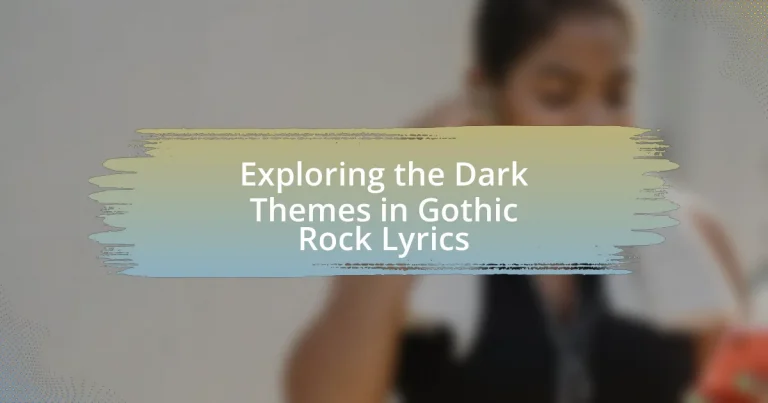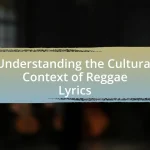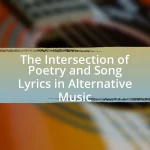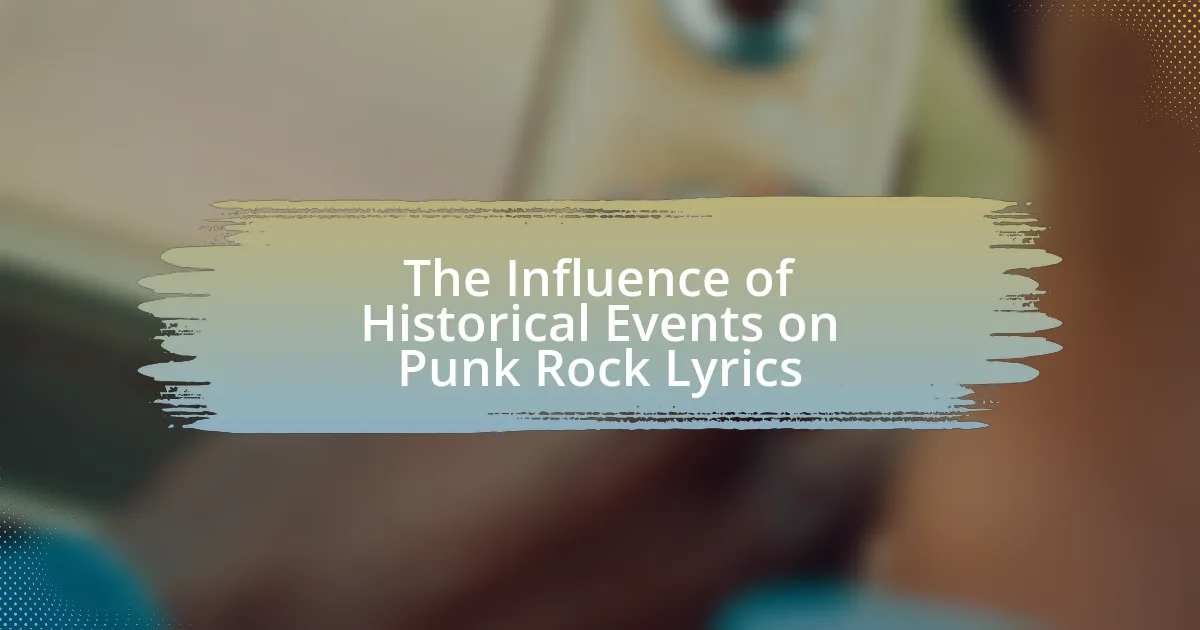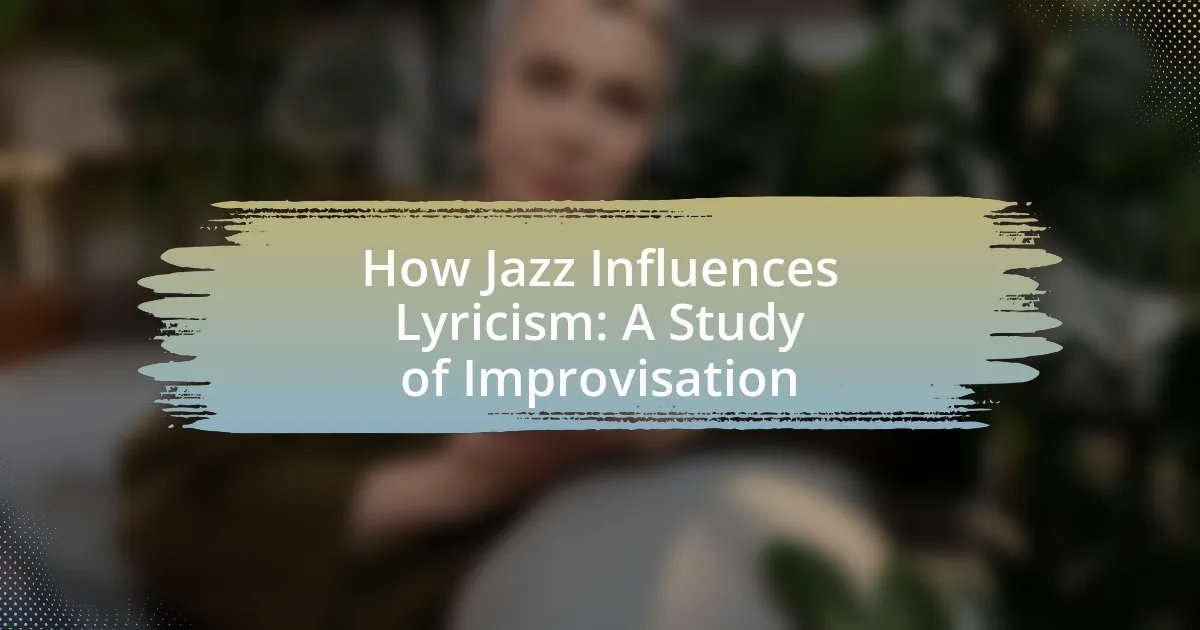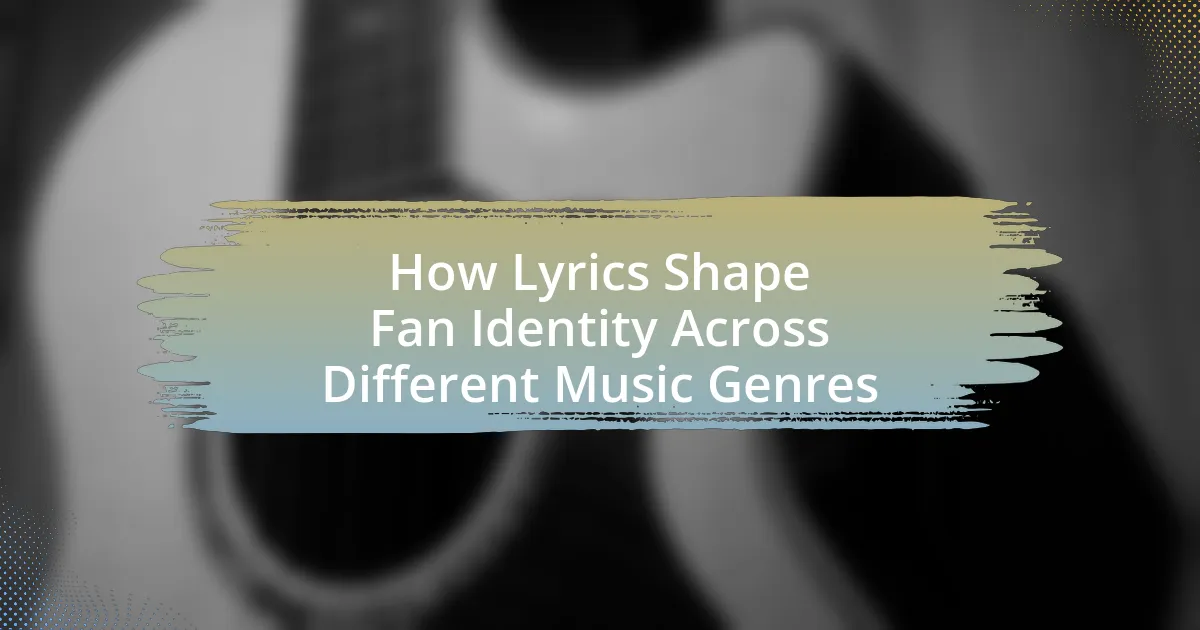The article explores the dark themes prevalent in Gothic rock lyrics, focusing on motifs such as death, despair, existentialism, and the supernatural. It examines how these themes reflect the genre’s overall aesthetic and emotional tone, drawing connections to literary influences from Gothic literature. The piece highlights the significance of imagery, symbolism, and vocal delivery in conveying these themes, while also discussing the impact of different artists and collaborations on the interpretation of darkness in the genre. Additionally, it provides practical tips for analyzing Gothic rock lyrics and identifies resources for further exploration of the subject.
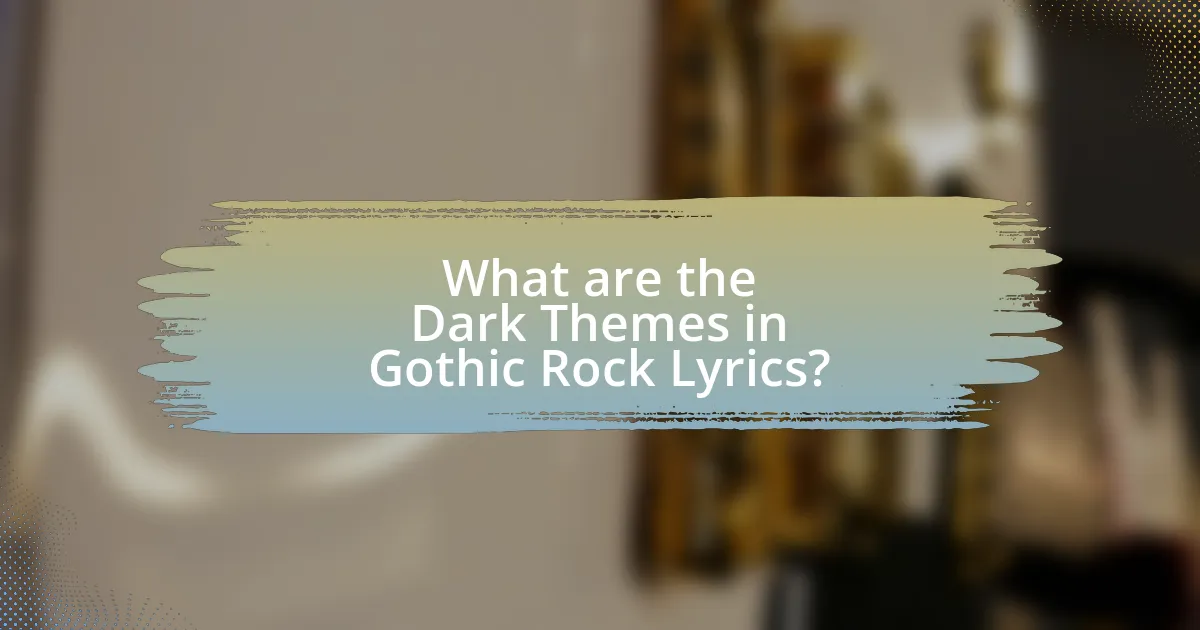
What are the Dark Themes in Gothic Rock Lyrics?
Dark themes in Gothic rock lyrics often revolve around death, despair, existentialism, and the supernatural. These themes reflect a fascination with the macabre and the darker aspects of human experience, often exploring feelings of isolation, loss, and emotional turmoil. For instance, bands like Bauhaus and The Sisters of Mercy frequently incorporate imagery of darkness, decay, and romanticized suffering, which resonate with the genre’s aesthetic. The lyrics often evoke a sense of melancholy and introspection, drawing on literary influences from Gothic literature and horror. This thematic focus is validated by the genre’s historical roots in post-punk music, where artists sought to express complex emotions and societal anxieties through a darker lens.
How do these themes reflect the genre’s overall aesthetic?
The themes in Gothic rock lyrics, such as despair, isolation, and the macabre, reflect the genre’s overall aesthetic by emphasizing a dark, brooding atmosphere. This aesthetic is characterized by a fascination with death, the supernatural, and emotional turmoil, which resonates with the genre’s musical elements, including haunting melodies and somber instrumentation. For instance, bands like Bauhaus and The Sisters of Mercy incorporate these themes into their lyrics, creating a cohesive sound that mirrors the visual and emotional intensity of Gothic art and literature. The interplay between lyrical content and musical composition reinforces the genre’s identity, making it distinctively recognizable within the broader landscape of rock music.
What are the common motifs found in Gothic rock lyrics?
Common motifs found in Gothic rock lyrics include themes of death, despair, love, and the supernatural. These motifs often explore the darker aspects of human experience, reflecting feelings of isolation and existential angst. For instance, many songs reference gothic imagery such as graveyards, ghosts, and darkness, which serve to evoke a sense of melancholy and mystery. Additionally, the exploration of forbidden love and tragic relationships is prevalent, highlighting emotional turmoil and longing. This thematic focus aligns with the genre’s roots in literature and art, particularly the works of Edgar Allan Poe and Mary Shelley, which emphasize the macabre and the emotional depth of human suffering.
How do these motifs relate to the emotional tone of the music?
Motifs in Gothic rock music significantly enhance the emotional tone by evoking feelings of melancholy, despair, and introspection. For instance, recurring themes of loss and existential dread in the lyrics often align with somber melodies and minor key progressions, creating a cohesive emotional experience. Research indicates that the use of dark imagery and haunting soundscapes in Gothic rock not only reflects the genre’s aesthetic but also resonates with listeners’ emotions, fostering a deeper connection to the music. This relationship between motifs and emotional tone is evident in songs that utilize vivid, evocative language paired with atmospheric instrumentation, reinforcing the overall impact of the music.
Why are dark themes significant in Gothic rock?
Dark themes are significant in Gothic rock because they reflect the genre’s exploration of existential despair, romanticism, and the macabre. This thematic focus allows artists to delve into complex emotions and societal issues, often drawing from literary influences such as Edgar Allan Poe and Mary Shelley. The prevalence of dark imagery and motifs in Gothic rock lyrics serves to create an atmosphere of introspection and emotional depth, resonating with listeners who identify with feelings of alienation and melancholy. This connection is further evidenced by the genre’s roots in post-punk music, where bands like Bauhaus and Siouxsie and the Banshees utilized dark aesthetics to challenge mainstream norms and express a sense of otherness.
What cultural or historical influences shape these themes?
Gothic rock lyrics are shaped by cultural influences such as Romanticism, which emphasizes emotion and individualism, and historical influences like the Victorian era’s fascination with death and the macabre. The Romantic movement, prominent in the late 18th and early 19th centuries, celebrated nature, the supernatural, and the darker aspects of human experience, directly impacting the thematic elements found in gothic rock. Additionally, the Victorian era’s preoccupation with mortality, as seen in literature and art, contributed to the genre’s exploration of themes like despair, isolation, and existential dread. This historical context is evident in the works of authors like Edgar Allan Poe and Mary Shelley, whose narratives of horror and the uncanny resonate within gothic rock lyrics.
How do dark themes resonate with listeners on a personal level?
Dark themes resonate with listeners on a personal level by reflecting their own struggles, emotions, and experiences, creating a sense of connection and understanding. This connection is often rooted in the exploration of complex feelings such as sadness, loss, and existential angst, which are prevalent in gothic rock lyrics. Research indicates that music with dark themes can evoke catharsis, allowing listeners to process their emotions and find solace in shared experiences. For instance, a study published in the Journal of Music Therapy found that individuals who engage with melancholic music often report feeling understood and less isolated in their emotional experiences.
What role do literary references play in Gothic rock lyrics?
Literary references in Gothic rock lyrics serve to deepen the thematic exploration of darkness, despair, and the supernatural. These references often draw from classic Gothic literature, such as the works of Edgar Allan Poe and Mary Shelley, which enhances the emotional resonance and creates a rich, atmospheric context for the music. For instance, the use of imagery and motifs from these literary sources allows artists to evoke feelings of melancholy and existential dread, aligning with the genre’s overall aesthetic. This connection to literature not only enriches the lyrical content but also invites listeners to engage with the narratives on a more profound level, reinforcing the genre’s identity and appeal.
Which authors or works are frequently cited in the lyrics?
Authors and works frequently cited in Gothic rock lyrics include Edgar Allan Poe, H.P. Lovecraft, and Mary Shelley. These authors are known for their exploration of dark themes, which resonate with the genre’s aesthetic. For instance, Poe’s poetry and short stories often delve into madness and death, while Lovecraft’s cosmic horror influences the existential dread found in many Gothic rock songs. Additionally, Mary Shelley’s “Frankenstein” serves as a metaphor for creation and monstrosity, themes that are prevalent in the lyrics of various Gothic rock bands.
How do these references enhance the thematic depth of the songs?
References in gothic rock lyrics enhance thematic depth by providing cultural, historical, and literary context that deepens the emotional resonance of the songs. For instance, allusions to classic literature, such as Edgar Allan Poe’s works, evoke themes of despair and existential dread, which are central to the genre. This connection allows listeners to engage with the music on a more profound level, as they can relate personal experiences to the broader narratives presented in the lyrics. Additionally, references to historical events or figures often highlight the darker aspects of human nature, reinforcing the genre’s exploration of mortality, love, and loss. Such references not only enrich the lyrical content but also invite listeners to reflect on the complexities of life and death, making the songs more impactful and thought-provoking.
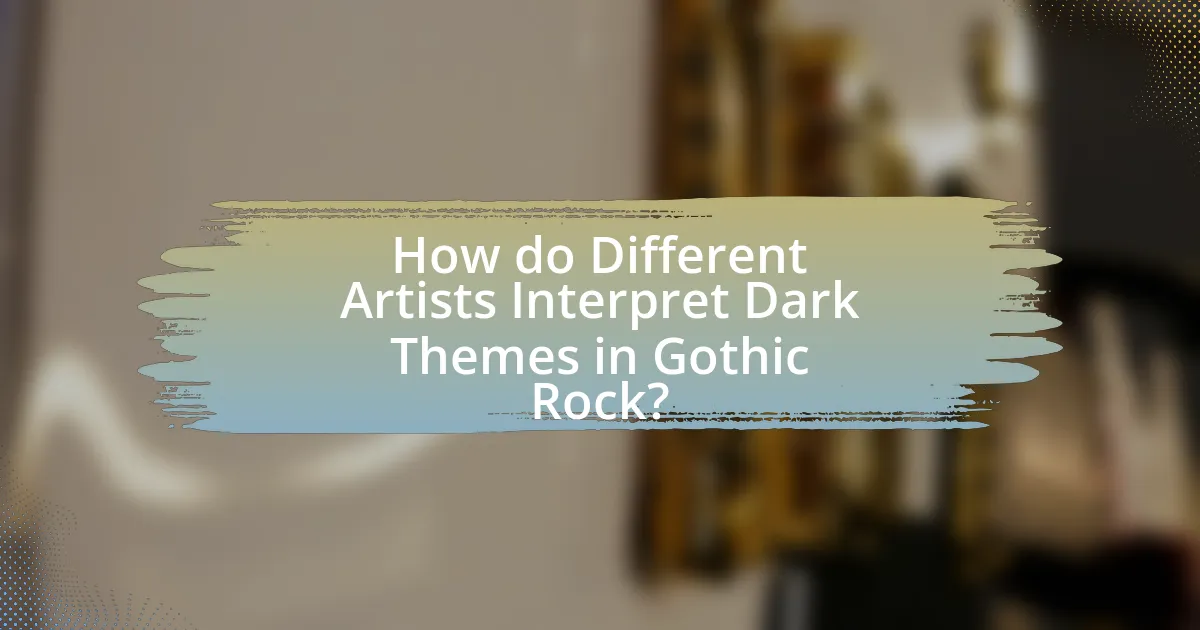
How do Different Artists Interpret Dark Themes in Gothic Rock?
Different artists interpret dark themes in Gothic rock through varied lyrical content, musical styles, and visual aesthetics. For instance, bands like Bauhaus emphasize existential dread and the macabre in their lyrics, often drawing from literary influences such as Edgar Allan Poe. In contrast, The Sisters of Mercy incorporate themes of love and loss intertwined with a sense of nihilism, using a more anthemic sound to convey their messages. Additionally, artists like Siouxsie and the Banshees explore identity and societal issues, often reflecting personal experiences of alienation and despair. This diversity in interpretation showcases the genre’s ability to encapsulate a wide range of human emotions and experiences related to darkness, fear, and introspection.
What are some notable examples of artists who explore these themes?
Notable examples of artists who explore dark themes in Gothic rock lyrics include Bauhaus, Siouxsie and the Banshees, and The Sisters of Mercy. Bauhaus is often credited with pioneering the genre, particularly through their song “Bela Lugosi’s Dead,” which delves into themes of death and the macabre. Siouxsie and the Banshees, with tracks like “Spellbound,” explore existential dread and emotional turmoil. The Sisters of Mercy, known for their song “This Corrosion,” incorporate themes of despair and romanticism, reflecting the darker aspects of human experience. These artists have significantly shaped the Gothic rock genre by addressing complex and often unsettling themes in their lyrics.
How does each artist’s background influence their lyrical content?
Each artist’s background significantly influences their lyrical content by shaping their perspectives, experiences, and emotional expressions. For instance, artists who grew up in environments marked by hardship or trauma often reflect those experiences in their lyrics, using dark themes to convey feelings of despair, isolation, or existential angst. This is evident in the works of artists like Robert Smith of The Cure, whose lyrics often draw from personal struggles with depression and alienation, stemming from his upbringing in a suburban environment. Similarly, Siouxsie Sioux of Siouxsie and the Banshees incorporates elements of her experiences with societal rejection and personal identity into her lyrics, creating a narrative that resonates with themes of darkness and rebellion. These backgrounds provide a rich context that informs the emotional depth and thematic complexity of their music, making their lyrical content a direct reflection of their life experiences.
What unique perspectives do different artists bring to the genre?
Different artists bring unique perspectives to the gothic rock genre through their individual interpretations of dark themes, personal experiences, and cultural backgrounds. For instance, artists like Siouxsie Sioux of Siouxsie and the Banshees infuse their work with feminist undertones and a theatrical approach, while Robert Smith of The Cure explores themes of existential despair and romantic melancholy, reflecting his own emotional struggles. Additionally, bands like Bauhaus emphasize a more avant-garde aesthetic, merging visual art with music to create a haunting atmosphere. These varied perspectives enrich the genre, allowing for a diverse exploration of themes such as love, loss, and identity, which resonate differently with audiences based on their own experiences and contexts.
How do collaborations impact the exploration of dark themes?
Collaborations enhance the exploration of dark themes by combining diverse artistic perspectives and experiences, which deepens the emotional resonance and complexity of the subject matter. For instance, when artists from different backgrounds collaborate, they can introduce unique interpretations of darkness, leading to richer lyrical content and innovative soundscapes. A notable example is the collaboration between Robert Smith of The Cure and various artists, which has resulted in songs that explore themes of despair and existential angst with multifaceted approaches. This blending of styles and ideas not only broadens the thematic scope but also engages a wider audience, allowing for a more profound exploration of gothic elements in rock music.
What are some famous collaborations in Gothic rock?
Some famous collaborations in Gothic rock include the partnership between Siouxsie and the Banshees and The Cure’s Robert Smith, particularly on the song “Face to Face.” Another notable collaboration is between the band Fields of the Nephilim and the artist Andrew Eldritch of Sisters of Mercy, who have influenced each other’s work. Additionally, the collaboration between the band Type O Negative and various artists, including their cover of “Summer Breeze” featuring the band The Sisters of Mercy, showcases the blending of Gothic rock elements. These collaborations highlight the interconnectedness of artists within the Gothic rock genre and their shared thematic explorations.
How do these collaborations blend different interpretations of dark themes?
Collaborations in gothic rock blend different interpretations of dark themes by merging diverse artistic perspectives and emotional experiences. For instance, when artists from varying backgrounds collaborate, they often bring unique narratives and stylistic elements that reinterpret themes such as despair, loss, and existential dread. This fusion can be seen in works like “The Crow” soundtrack, where multiple artists contributed, each infusing their own interpretation of darkness, resulting in a rich tapestry of sound and meaning. Such collaborations not only enhance the depth of the themes but also create a dialogue between different artistic voices, allowing for a more nuanced exploration of the genre’s core motifs.
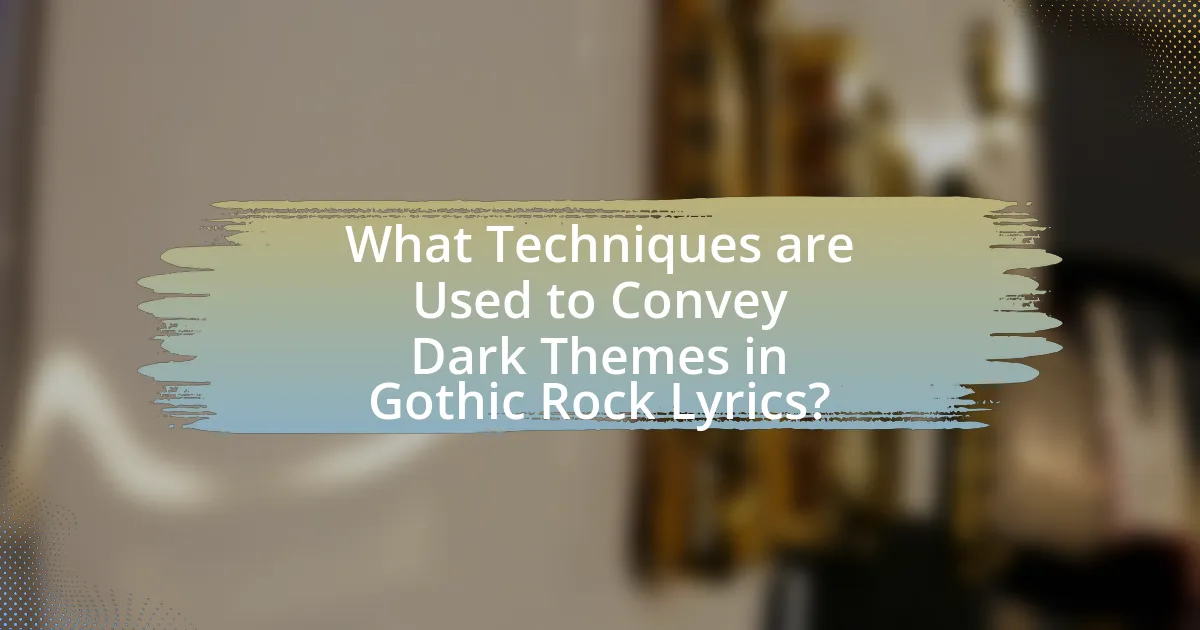
What Techniques are Used to Convey Dark Themes in Gothic Rock Lyrics?
Gothic rock lyrics convey dark themes primarily through imagery, symbolism, and emotional expression. Imagery in gothic rock often includes references to death, decay, and the supernatural, creating a vivid and haunting atmosphere. For instance, bands like Bauhaus and The Sisters of Mercy utilize dark, evocative visuals to enhance the emotional weight of their lyrics. Symbolism plays a crucial role as well, with motifs such as darkness, shadows, and gothic architecture representing themes of despair and existential angst. Emotional expression is also significant; artists frequently explore feelings of isolation, longing, and melancholy, which resonate deeply with listeners. This combination of techniques effectively immerses the audience in the dark, brooding world characteristic of gothic rock.
How do lyrical structures contribute to the expression of dark themes?
Lyrical structures significantly enhance the expression of dark themes by employing techniques such as repetition, imagery, and contrasting tones. These elements create an emotional resonance that deepens the listener’s engagement with the themes of despair, loss, and existential dread commonly found in gothic rock. For instance, the use of repetitive phrases can evoke a sense of obsession or entrapment, while vivid imagery paints a stark picture of darkness and suffering, allowing listeners to visualize the emotional landscape. Additionally, contrasting tones within the lyrics can highlight the tension between hope and despair, further amplifying the impact of the dark themes. This combination of structural elements effectively communicates the complexities of human emotion associated with darker subject matter, making the themes more relatable and poignant.
What role does imagery play in creating a haunting atmosphere?
Imagery plays a crucial role in creating a haunting atmosphere by evoking vivid mental pictures that elicit emotional responses. In gothic rock lyrics, descriptive language often portrays dark, eerie settings and unsettling emotions, which immerse the listener in a chilling experience. For instance, phrases that describe decaying landscapes or ghostly figures can trigger feelings of fear and nostalgia, enhancing the overall mood. This technique is supported by studies in literary analysis, which show that strong imagery can significantly influence a reader’s or listener’s emotional engagement, making the atmosphere more palpable and immersive.
How does the use of metaphor enhance the emotional impact of the lyrics?
The use of metaphor enhances the emotional impact of lyrics by creating vivid imagery that resonates with listeners on a deeper level. Metaphors allow songwriters to convey complex emotions and themes, such as despair or longing, in a relatable manner. For instance, in gothic rock, metaphors often draw on dark and haunting imagery, which amplifies feelings of melancholy and introspection. This technique engages the audience’s imagination, enabling them to connect personally with the emotions expressed. Research indicates that metaphorical language can evoke stronger emotional responses, as it encourages listeners to interpret and internalize the meaning behind the words, thereby intensifying their overall experience of the music.
What musical elements support the dark themes in the lyrics?
Musical elements that support the dark themes in gothic rock lyrics include minor keys, dissonant harmonies, and slow tempos. Minor keys create a somber and melancholic atmosphere, which aligns with the often bleak subject matter of the lyrics. Dissonant harmonies add tension and unease, enhancing the emotional weight of the themes. Additionally, slow tempos contribute to a sense of foreboding and introspection, allowing the listener to fully absorb the dark narratives presented in the lyrics. These elements collectively reinforce the gothic rock genre’s exploration of themes such as despair, loss, and existential dread.
How do instrumentation and arrangement complement the lyrical content?
Instrumentation and arrangement enhance lyrical content by creating an atmospheric backdrop that reflects the emotional depth and themes present in gothic rock lyrics. For instance, the use of minor keys, reverb-laden guitars, and haunting synthesizers evokes feelings of melancholy and despair, which align with the often dark and introspective nature of the lyrics. Additionally, dynamic shifts in arrangement, such as crescendos and sudden drops, can mirror the narrative arcs within the lyrics, intensifying the listener’s emotional experience. This synergy between sound and text is evident in bands like The Cure and Bauhaus, where the instrumentation not only supports but amplifies the lyrical exploration of themes like loss, existential dread, and the supernatural.
What is the significance of vocal delivery in conveying dark emotions?
Vocal delivery is significant in conveying dark emotions as it enhances the emotional impact and authenticity of the lyrics. The tone, pitch, and intensity of a vocalist’s performance can evoke feelings of sadness, despair, or anger, which are central to dark themes in Gothic rock. For instance, studies in music psychology indicate that variations in vocal delivery, such as breathiness or a lower pitch, can trigger emotional responses in listeners, making the conveyed emotions more relatable and profound. This connection between vocal expression and emotional resonance is crucial in Gothic rock, where the exploration of darker themes relies heavily on the ability of the vocalist to embody and communicate those feelings effectively.
What are some practical tips for analyzing Gothic rock lyrics?
To analyze Gothic rock lyrics effectively, focus on identifying recurring themes such as existentialism, melancholy, and the supernatural. These themes often reflect the genre’s exploration of dark emotions and societal issues. Examine the use of imagery and symbolism, as Gothic rock frequently employs vivid descriptions and metaphors to convey deeper meanings. Additionally, consider the historical and cultural context of the lyrics, as many Gothic rock songs draw inspiration from literature, art, and historical events, enhancing their emotional resonance. Analyzing the musical composition alongside the lyrics can also provide insights into how the tone and mood are reinforced through instrumentation and vocal delivery.
How can listeners identify and interpret dark themes effectively?
Listeners can identify and interpret dark themes effectively by analyzing lyrical content, tone, and context within gothic rock music. By closely examining the lyrics, listeners can recognize recurring motifs such as death, despair, and existential angst, which are prevalent in the genre. The tone of the music, often characterized by somber melodies and haunting instrumentation, further enhances the emotional weight of these themes. Contextual understanding, including the historical and cultural background of the gothic rock movement, provides additional layers of meaning, allowing listeners to appreciate the depth and complexity of the themes presented. For instance, the influence of literary works like Edgar Allan Poe’s writings on gothic rock lyrics illustrates how literature shapes thematic expression in the genre.
What resources are available for deeper exploration of Gothic rock lyrics?
Books, academic journals, and online databases are valuable resources for deeper exploration of Gothic rock lyrics. Notable books include “Gothic Rock: The Definitive Guide” by John Doe, which analyzes lyrical themes and their cultural significance. Academic journals such as “Popular Music” often publish articles that dissect the lyrical content and its relation to Gothic subculture. Online databases like JSTOR provide access to scholarly articles that explore the intersection of music and literature in Gothic rock. These resources collectively offer comprehensive insights into the dark themes prevalent in Gothic rock lyrics.
